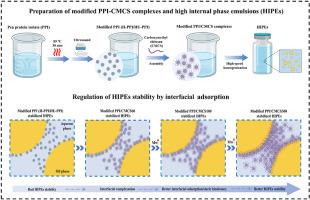Effect of molecular weight of carboxymethyl chitosan on the properties of modified pea protein isolate-carboxymethyl chitosan complexes and its potential as stabilizer for high internal phase emulsions
IF 11
1区 农林科学
Q1 CHEMISTRY, APPLIED
引用次数: 0
Abstract
Although pea protein isolate (PPI) shows great potentials in the replacement for grain-based and animal-derived proteins with its affordability, hypoallergenic properties, and nutritional advantages, its application was largely hindered by its poor solubility and emulsification ability. This research investigated the possibility of enhancing the functional properties of PPI using a combination of heat (H-PPI) or heat-ultrasound treatment (HU-PPI) and the incorporation of carboxymethyl chitosan (CMCS) with different molecular weight. The stability of high internal phase emulsion (HIPEs, oil phase ratios of 75 %) stabilized by modified PPI/CMCS complexes at a low addition amount (15 mg/mL) was investigated. The results revealed that hydrogen bonding, electrostatic forces, and hydrophobic interactions drove H-PPI/HU-PPI to assemble with CMCS, altering protein secondary structures to form more ordered configurations. The solubility, contact angle, and emulsifying properties of PPI were significantly improved as a result. Additionally, the interfacial tension was reduced, and the HU-PPI-CMCS300 was the lowest (<10 mN/m). Then, HIPEs were fabricated by PPI and PPI/CMCS complexes. The chemical and physical stability of HIPEs was enhanced by modifying PPI and was further increased by complexing with CMCS. The HIPEs prepared by complexes with a higher molecular weight of CMCS showed higher protein adsorption, closer droplet packing, and smaller oil droplets (HU-PPI-CMCS300 was <10 μm), which led to improved HIPEs stability. These results highlight the importance of molecular weight of CMCS on the functional properties of modified PPI/CMCS complexes. The study also offered theoretical basis for stable HIPEs made from complexes of proteins and polysaccharides.

羧甲基壳聚糖分子量对改性豌豆分离蛋白-羧甲基壳聚糖配合物性能的影响及其作为高内相乳液稳定剂的潜力
尽管豌豆分离蛋白(pea protein isolate, PPI)以其低廉的价格、低过敏性和营养优势在替代谷物和动物源性蛋白方面显示出巨大的潜力,但其溶解性和乳化性差在很大程度上阻碍了其应用。本研究探讨了热(H-PPI)或热超声(HU-PPI)联合处理和不同分子量羧甲基壳聚糖(CMCS)的掺入提高PPI功能性能的可能性。考察了改性的PPI/CMCS配合物在低添加量(15 mg/mL)下稳定高内相乳液(HIPEs,油相比为75%)的稳定性。结果表明,氢键、静电力和疏水相互作用驱动H-PPI/HU-PPI与CMCS组装,改变蛋白质二级结构,形成更有序的构型。结果表明,PPI的溶解度、接触角和乳化性能都得到了显著改善。界面张力降低,其中HU-PPI-CMCS300最低(10 mN/m)。然后用PPI和PPI/CMCS复合物制备HIPEs。通过对PPI的修饰,HIPEs的化学和物理稳定性得到了提高,并通过与CMCS络合进一步提高了HIPEs的化学和物理稳定性。高分子量CMCS配合物制备的HIPEs具有更高的蛋白质吸附能力、更紧密的液滴填充、更小的油滴(HU-PPI-CMCS300为10 μm),从而提高了HIPEs的稳定性。这些结果强调了CMCS分子量对改性PPI/CMCS配合物功能特性的重要性。该研究也为构建稳定的蛋白质-多糖复合物HIPEs提供了理论基础。
本文章由计算机程序翻译,如有差异,请以英文原文为准。
求助全文
约1分钟内获得全文
求助全文
来源期刊

Food Hydrocolloids
工程技术-食品科技
CiteScore
19.90
自引率
14.00%
发文量
871
审稿时长
37 days
期刊介绍:
Food Hydrocolloids publishes original and innovative research focused on the characterization, functional properties, and applications of hydrocolloid materials used in food products. These hydrocolloids, defined as polysaccharides and proteins of commercial importance, are added to control aspects such as texture, stability, rheology, and sensory properties. The research's primary emphasis should be on the hydrocolloids themselves, with thorough descriptions of their source, nature, and physicochemical characteristics. Manuscripts are expected to clearly outline specific aims and objectives, include a fundamental discussion of research findings at the molecular level, and address the significance of the results. Studies on hydrocolloids in complex formulations should concentrate on their overall properties and mechanisms of action, while simple formulation development studies may not be considered for publication.
The main areas of interest are:
-Chemical and physicochemical characterisation
Thermal properties including glass transitions and conformational changes-
Rheological properties including viscosity, viscoelastic properties and gelation behaviour-
The influence on organoleptic properties-
Interfacial properties including stabilisation of dispersions, emulsions and foams-
Film forming properties with application to edible films and active packaging-
Encapsulation and controlled release of active compounds-
The influence on health including their role as dietary fibre-
Manipulation of hydrocolloid structure and functionality through chemical, biochemical and physical processes-
New hydrocolloids and hydrocolloid sources of commercial potential.
The Journal also publishes Review articles that provide an overview of the latest developments in topics of specific interest to researchers in this field of activity.
 求助内容:
求助内容: 应助结果提醒方式:
应助结果提醒方式:


